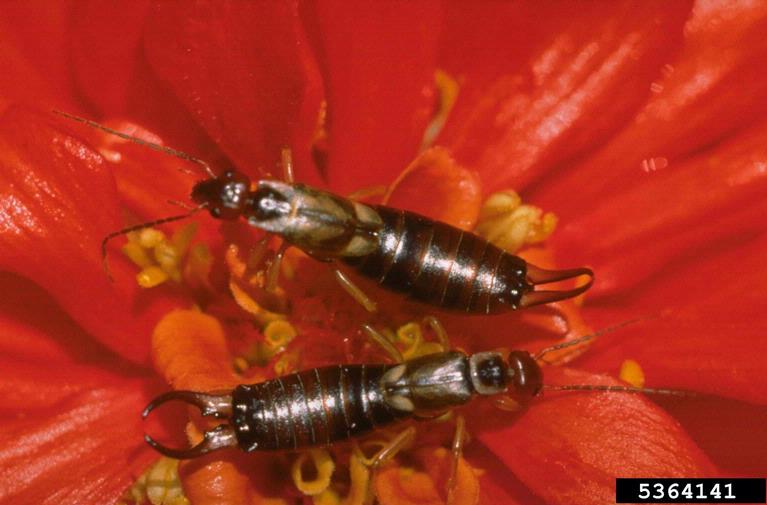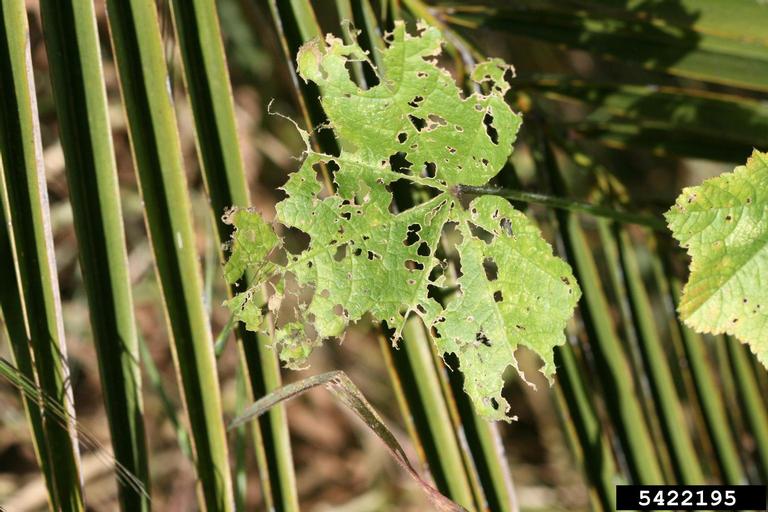European Earwigs - September 21, 2016 Jeff Schalau, Agent, Agriculture & Natural Resources University of Arizona Cooperative Extension, Yavapai County European earwigs are common in Arizona and are easily recognized by the large pincers on the end of their bodies. Earwigs are known to be beneficial, acting as decomposers and predators of insect pests such as aphids and scales. They usually do not cause extensive damage to crops, but now and then they feed on vegetables, leafy greens, flowers, and a variety of fruit. Originally from Europe, the European earwig, Forficula auricularia, was introduced into the U.S. in the early 1900's and is now common throughout much of the country. It first became noticeable in Wisconsin in the early 1980's and Minnesota in the early 1990's and has since been present in varying numbers. They get their name from the old belief that earwigs climb into people's ear while they are sleeping. While they have been found in peoples ears on rare occasion, it is very uncommon and not a normal behavior. Earwigs are about 5/8 inch long, with a flat, reddish brown body and very short wings. They have medium length antennae and chewing mouthparts. They are distinctive because they possess a pair of strong pinchers (cerci) on the tip of their abdomen. Males have stout, strongly curved cerci that are widely separated at the base while females possess slender, straight pinchers that are close together. Earwigs use these cerci to protect themselves and to grab and hold prey. Earwigs go through simple metamorphosis to become adults. Immature earwigs are called nymphs, resemble small adults, and typically have external wing buds (short, developing wings). Earwig nymphs use the same food sources as adults and appear similar except they are smaller. Earwig nymphs have female-like, slender straight cerci and are generally lighter in color than adults. Earwigs are most active at night and hide during the day in dark, confined, damp areas and are found under potted plants, leaves, door mats, and other objects, as well as in cracks between pavers, bricks, and similar places. You can also find them on plants in buds and folded leaves. Earwigs are scavengers feeding on damaged and decaying plant matter as well as weakened or dead insects and other small organisms. As mentioned above, earwigs can also feed on healthy plant material. Earwigs mate in the fall and males and females usually spend the winter together in specially constructed nests. In early spring, females force the males out and then lay eggs. Female earwigs are very maternal, an unusual trait for insects. They guard and protect their eggs and newly hatched young. Eggs hatch within about a week. Earwig nymphs emerge from nests sometime from late May to early June, maturing into adults in late June or early July. Adults are active through fall. In addition damaging plants, Earwigs can enter homes and other buildings during summer where they are viewed as a nuisance pest. They do not damage property or eat our food nor do they reproduce indoors. Earwigs do give off a disagreeable odor as they can secrete a foul-smelling liquid from their abdomen. An individual earwig does not live long indoors, but they can continue to migrate into buildings throughout the summer. Earwigs can usually be managed without the use of chemical insecticides. First, clean up debris that earwigs can hide under, such as leaves, plant debris, bricks, piles of lumber and similar things. You can set out rolled up newspapers or similar objects to trap earwigs. You can also place old tuna fish cans baited with fish oil or vegetable oil. Set them out during evening in areas where you are seeing earwigs in your garden. In morning, shake the traps above a pail of soapy water to remove and kill the insects. To help keep earwigs out of your home, caulk and repair any obvious spaces, cracks, or gaps around the outside of your home at ground level, especially around doors and windows and the juncture of the siding and the foundation. However, if earwigs are determined, some will still get inside your home. For any earwigs you find inside, just remove them with a vacuum or a broom and dust pan. See below for additional resources. Follow the Backyard Gardener on Twitter – use the link on the BYG website. If you have other gardening questions, call the Master Gardener help line in the Camp Verde office at 928-554-8992 or e-mail us at verdevalleymg@gmail.com and be sure to include your name, address and phone number. Find past Backyard Gardener columns or provide feedback at the Backyard Gardener web site: http://cals.arizona.edu/yavapai/anr/hort/byg/. Additional Resources European Earwig Utah State University Extension extension.usu.edu/files/publications/factsheet/earwig-orn.pdf European Earwigs in Homes and Gardens University of Minnesota Extension www.extension.umn.edu/garden/insects/find/earwigs/  Male and female European earwigs (Forficula auricularia). Males have curved cerci (below) and females have straight cerci (above). Photo Credit: Whitney Cranshaw, Colorado State University, Bugwood.org.  European earwig (Forficula auricularia) damage to common mallow (Malva neglecta) foliage. Photo Credit: Whitney Cranshaw, Colorado State University, Bugwood.org. |